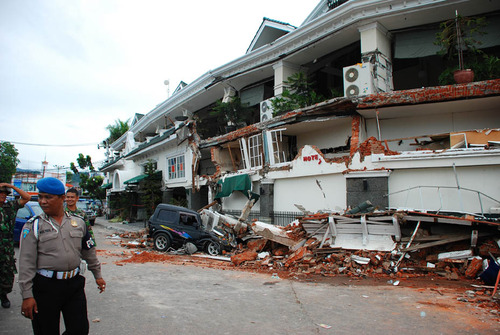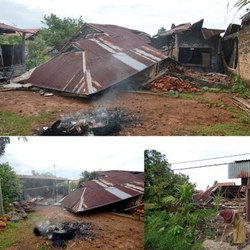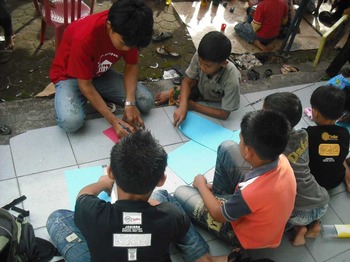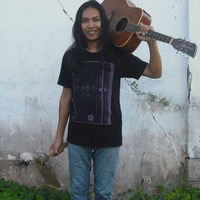Story and Photos By Kayti Denham
Bali, 27 July 2010. Padang, West Sumatra lies along the Pacific "Ring of Fire". Last September, the city and its surrounding areas were devastated by a 7.6 magnitude quake which left communities shattered, lost and grieving.

One year on, large parts of Padang still remain devastated.
One year on, the damage that remains is still visible; buildings yet to be demolished or repaired are crumpled alongside newly renovated structures in the centre of the city. In the suburbs, patchwork walls and construction sites are squeezed between still standing homes and the evidence of rebuilding from timber supplies to corrugated iron sheets can be seen from almost every street corner. In outlying areas, shelters still house people who are unable to rebuild.

Rebuilding is beyond some folks.
The process of reclaiming lives, rebuilding homes and regaining a foothold in some form of normal existence is still in its early stages. Many organizations are involved in this process, from the Indonesian national and regional government agencies to small and big non-governmental organisations (NGOs) and International Aid Organizations, such as the Red Cross.
Gaia Discovery was invited to observe the work of one of the International- local collaboration projects taking place that is funded through an alliance between the Australian and Indonesian Government as the Australia-Indonesia Facility for Disaster Reduction and run under the auspices of IDEP, a Bali based disaster management NGO.
The aim of the project is to distribute media that can help communities understand the many aspects of the rebuilding process, informing them of their rights to compensation and to spread awareness of sustainable, earthquake safe building techniques, the correct use of materials in construction and information on disaster awareness.

New housing built for the survivors.
Designed to have a strong visual impact, the print media comes in the form of banners, brochures, posters, manuals, books, calendars and comic books, allowing for clear understanding no matter the age of literacy level of the reader. Local actors from the Padang theatre and arts world also combined forces with film directors to create an informative story style drama that follows the fortunes of a family affected by the quake that can be shown in public spaces. And this is where the fun comes in.
Any organization facing the challenge of getting information out needs to find a fresh approach. IDEP's Balinese representative, Robi was particularly concerned that people should receive the message in ways that create a sense of ownership, of community belonging and sharing rather than a message delivered by outsiders and imposed on a disconnected audience of 'onlookers'.
To achieve this he sought out the alternative arts scene in Padang and through a fortunate connection met up with Kiwi Sudarsho, a talented photographer and artist who gathered around him a group of youths; enthusiastic artists, painters and musicians to organically grow a 'tribe' of committed artist performers who could go out into the communities from the cities into the more remote regions to present the film, distribute the media and put on a whole day event of art, mural making, music and performance in conjunction with village leaders.

Art paints the way forward for these helpless, not hopeless, kids.
I joined the happy collective on their trip into Maninjau, a beautiful volcanic lake area in the hills beyond Padang on the road to Bukit Tinggi.
Three hours from Padang the road opens out into a magical vista of the vast calm waters of Lake Mininjau. The air is fresh and cool and the vegetation lush and fragrant; a seemingly placid paradise that at first veils the scars of its recent destruction with its potent natural beauty and gentle rural comings and goings.
On alighting the bus in the town square preparations that have been organized well in advance, begin. There will be recycled art activities for the kids, a painting competition, a media distribution and on dusk the local performers will take centre stage and begin a program of dance, music and martial arts display, interspersed with the film, speeches from the town's leader, Robi from IDEP and the local religious leader. Also, an open discussion is held, hosted by a representative ofAndalas University Construction Clinic for technical information about safe-building practices.

Robi believes that music can heal.
In their bright red T-shirts, the band of artists attracts crowds of kids leaving school for the day and soon the activities are underway. While this is happening another group leave the square to distribute the media in the nearby temporary shelters, specifically built for those who have lost their homes. Here crowds gather around the visitors, eagerly accepting the comics and brochures, gathering up smaller family members to see what's going on.
The community is lively and welcoming, the stark impact of the basic condition of the housing, and the sense of loss that must dwell within each person is dissolved in their smiles and their survival.
They are not victims; they are survivors.
As the 'tribe' moves through the camp talking with residents of all ages it is clear that the messages they bring are important ones, and that these young local people who have given their time to come out are seen as an important connection to the wider community by those who stop to talk.
Survivor, not victim.
Come sunset, the square is beginning to fill. The end of prayers brings people in for the evening and as the light drains from the sky leaving only arcs of illumination and the shimmering of the projected images on the screen the entertainments begin. The film is well received, the dancers perform their traditional dances and the drummers go wild in their quest for the ultimate rhythm. Speeches are applauded, food is eaten and a community gathers together, kids underfoot and on shoulders, teens leaning against motorbikes and the elders seated in chairs.
And it is in this atmosphere that a community knits and heals, hears and understands that the help provided can be held in their hands.
ABOUT IDEP
http://www.idepfoundation.org
Yayasan IDEP is an Indonesian non-profit NGO (Non-Governmental Organization). IDEP encourages program sharing with other grass roots projects through media and curriculum development. They are committed to developing self-sustainability and directly empowering local communities to improve their own situations. IDEP believes that permanent results can be achieved through local empowerment.
Donations to IDEP that will assist them in continuing to fund projects can be made through their website
http://www.idepfoundation.org/idep_donate.php

